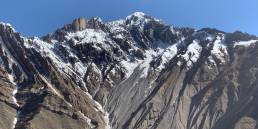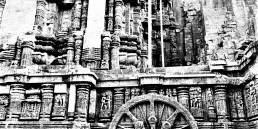CONQUERING THE MIGHTY HIMALAYAN MOUNTAIN PASSES
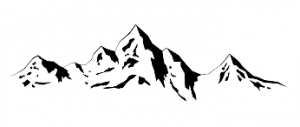 Visiting Ladakh and traveling through the Mighty Himalayan mountains was like fulfilling a wish from life’s bucket list. But, it had a greater, much deep-seated impact than I had expected!!
Visiting Ladakh and traveling through the Mighty Himalayan mountains was like fulfilling a wish from life’s bucket list. But, it had a greater, much deep-seated impact than I had expected!!

Ladakh landscape, Leh-Hunder Road (Photo Credit: Author)
Me and my husband Mihir had been planning a bike trip to Ladakh since our 20s. But all these years life kept happening and we couldn’t get on with this trip until we hit our golden 40. Since a bike trip was now out of question we strapped our responsibilities in the form of two kids and essentials for the long journey into our 4X4 SUV and set off on an adventurous 10-day trip through the mighty Himalayas.
Elaborating a bit about the fabled Himalayas, the Himalayan mountain range is the world’s highest mountain range, is around 40-50 Million years old but still the youngest mountain range in the world. The name “Himalaya” is derived from two words in Sanskrit. “Hima” means Snow and “a-laya” means dwelling. The Himalayan mountain range has 10 of the 14 world’s highest peaks and in India passes through the states of Himachal Pradesh, Uttarakhand, the North-Eastern states, and UTs of Jammu, Kashmir, and Ladakh. Ladakh is the highest plateau in India and is towards the extreme top part of the country. In Tibetan “La dak” means the “land of high passes”. Despite the harsh climatic conditions Ladakh has been inhabited since Neolithic times. The natural beauty of Ladakh is wild, pure and none like that found anywhere else in India.

NH1, between Baltal and Sonmarg, Kashmir (Photo Credit: Author)
Coming to our story, we had always wanted to take a road trip to Ladakh, the foremost reason being one can experience Ladakh, the wilderness, the snow, the mountains, and ravines much better while traveling by road than any other means. Secondly, in many regions of Ladakh oxygen level is quite low and one experiences altitude sickness in the form of breathing difficulties, nausea, dizziness, headache, etc. A gradual ascend while travelling via road helps to acclimatize better as compared to traveling by flight.

Sheep grazing in the meadows in Dras, Ladakh (Photo Credit: Author)
We started our journey from Noida, Uttar Pradesh crossing three states Haryana, Punjab, Himachal Pradesh, and the Union territory of Kashmir and reached Ladakh in two days. While going we took the route via Srinagar and returned via Manali. Via Srinagar, the ascend is gradual as compared to via Manali thus aiding in acclimatization.
Our first stop was Kargil. River Suru, the tributary of Indus, passes through Kargil. The barren hills around still evoke fear, a reminder of the fierce battle that shook our country and neighbor Pakistan in 1999. But then the hustle and bustle of the market and the Indian Army positioned at strategic points make you feel safe.
After halting for the night, we moved to our next destination which was Saspol, a village settlement in the outskirts of Leh City. Our Hotel over-looked the mountains and was surrounded by mustard fields. The next day we visited Leh city for some sight-seeing. We visited the Shanti Stupa perched on top of a mountain providing fabulous panoramic view of the city. Our plans to visit Leh Palace was squashed as the entrance to the palace was via narrow winding roads and our SUV got stuck a couple of times. We wound up the day by shopping for ladakhi and Tibetian trinkets in Leh market. Unfortunately, next day morning, I started experiencing altitude sickness and ended up in a govt. PHC (public health center). After taking some medications, we were on road again for our next destination.
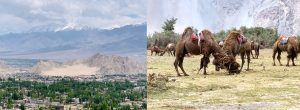
Left: Panoramic View of Leh City from Shanti Stupa, Leh, Ladakh (Photo Credit: Author) Right: The double-humped Bactrian camels in Hunder desert, Nubra valley, Ladakh (Photo Credit: Author)
Our next destination was Nubra Valley. The Rivers Nubra and Shyok confluence at this point. The valley also has a desert called the Hunder desert. One of the few high-altitude deserts in the world.
Hunder desert is well known for adventure sports and double-humped Bactrian camels. The place also boasts of the Diskit Gompa and the Maitrei Budha atop two adjacent hills. This area is prone to dust storms quite often.
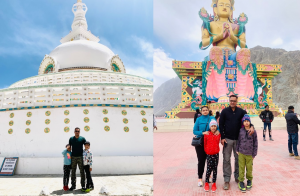
Left: Shanti Stupa, Leh, Ladakh, Right: Maitreya Budha Statue, near Diskit Gompa, Ladakh (Photo Credit: Author)
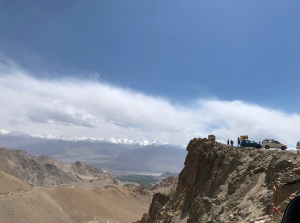 View along KhardungLa road, Ladakh (Photo Credit: Author)
View along KhardungLa road, Ladakh (Photo Credit: Author)
Just when we were planning to return a dust storm started which lasted about 20 mins and everyone ran to the nearest possible shelter. We ran towards our car. After a good night rest, we travelled further up towards our next destination.
Next up was Pangong Tso lake. It is a saltwater lake considered sacred by locals, one should not get caught bathing or messing around here. More than half of Pangong lake is in China. We stayed in the homestay of a local Ladakhi family in Mann Village overlooking the Pangong Lake. They served us lovely homecooked meals. The area around Pangong Lake is very beautiful where many movies have been shot, the most famous is the Bollywood cult movie “3 Idiots”. In Pangong I experienced altitude sickness even more. I was extremely dizzy and nauseated for a good many hours.

Pangong Tso, Ladakh (Photo Credit: Author)
With Pangong we came to the last leg of our journey. On our way back, we took the Leh-Manali route with a day’s halt at Manali. It was a very tiresome 14-hour drive because of traffic jams at various places and we had to go off-road many times because of broken roads. We stayed in the log-hut cabin area in Old Manali, full of greenery and tall trees. The River Manalsu runs alongside, lined with cafes and restaurants on both its side.
In these 10 days while traveling through this entire circuit we went through many mountain passes. Some of them are among the highest motorable roads of India as well as the world. First, we crossed the mountain pass of Zoji La situated at a height of 11,575 ft above Msl. This acts as a vital link between Kashmir valley and Ladakh valley.
Then we crossed the Khardung La pass which is at a height of 17982ft above Msl. It forms the gateway to the Nubra valley. Close by is also the Siachen Glacier. A sign there says not to stay for more than 20 minutes because of the extremely low levels of oxygen. This road is closed from approximately October to May due to heavy snow.
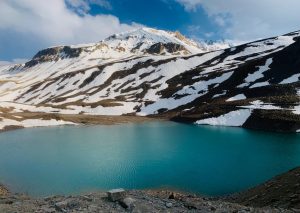
Suraj Tal, near Keylong, Ladakh (Photo Credit: Author)
When we travelled from Pangong to Leh we came across Chang La pass at a height of 17688 Ft above Msl. The stretch of 10–15 km road on either side of Chang la has heavy snow and becomes loose dirt and slush after the winter requiring regular maintenance.
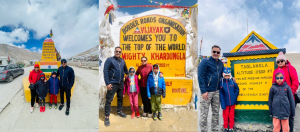
ChangLa,KhardungLa and Taglang La pass (Photo Credit: Author)
On the way to Manali from Leh we passed through a few other mountain passes like Taglang La at 17582ft, then Nakee La at 15547 ft, and Baralacha La at 15910 ft (Lahaul district in Himachal Pradesh to Leh district in Ladakh).
We couldn’t visit the Rohtang La pass at 13058 ft which connects the Kullu Valley with the Lahaul and Spiti Valleys and lies close to Manali but it’s a major tourist attraction.
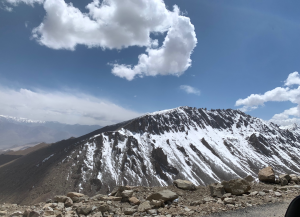
Snow-covered mountain peaks near KhardungLa pass, Ladakh (Photo Credit: Author)
The trip through Ladakh and the high passes was quite invigorating and left a deep impact on me. In I sum up my experience and what it taught into few lines, they can be as below:
- The mountains around are so huge and us so small in front of them, their majesticity humbles you.
- Going through the Himalayan passes is like taking the most treacherous roads and when you finally make it to the top, means you survived. It makes you believe in your chances in life.
- The landscape is barren, hills rugged, roads winding and narrow, climate harsh, but the people simple and smiling, the culture rich, banners colorful, and language sweet. The impression left behind is happy and long-lasting.
- Then there are those little plants popping out of barren rugged mountains, in the harshest of climates, sending a humble message to those who are listening that even in the harshest of situations, life will keep happening and you can survive. Only the master above has the capacity to call it a day. So, don’t quit just yet, hang in there.




